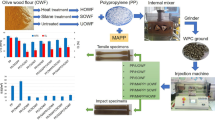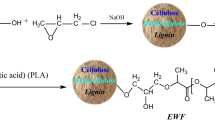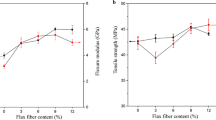Abstract
Wood flour (WF)/polypropylene (PP) composites have been made by extrusion and hot press compression molding. The composite water uptake and flexural properties were investigated. The composite fracture surfaces were studied by SEM. WF esterified with octanoyl chloride was used in WF/PP composites to improve the composites’ water resistance. Maleated polypropylene (MAPP) was also studied and compared with esterification by acid chlorides. Esterification by octanoyl chloride reduced the composite water uptake. However, the C8 chain is still not long enough to form effective entanglements with the PP matrix. So, despite enhancements in hydrophobic interactions, flexural strengths and flexural moduli decreased. MAPP (MW = 47000) polymer chains can entangle with the matrix polypropylene molecules. Therefore, when MAPP’s maleic anhydride functions esterify WF surface hydroxyls, improved water resistance and composite flexural properties were achieved. The modifier chain length is of critical importance and more important than the surface density of hydrophobic groups for improving WF–PP interfacial adhesion and composite mechanical performance.










Similar content being viewed by others
References
Clemons CM (2000) Proceedings of the 3rd international wood and natural fibre composites symposium, Kassel, Germany
Magurno A (1999) Die Angewandte Makromolekulare Chemie 272(1):99
Bledzki AK, Faruk O, Sperber VE (2006) Macromol Mater Eng 291(5):449. doi:https://doi.org/10.1002/mame.200600113
Tshabalala MA, Kingshott P, Vanlandingham MR, Plackett D (2003) J Appl Polym Sci 88:2828. doi:https://doi.org/10.1002/app.12142
Tserki V, Matzinos P, Kokkou S, Panayiotou C (2005) Compos, Part A 36:965. doi:https://doi.org/10.1016/j.compositesa.2004.11.010
Zhang C, Li KC, Simonsen J (2004) J Adhes Sci Technol 18:1603
Ellis WD, O’Dell JL (1999) J Appl Polym Sci 73:2493
Sèbe G, Tingaut P, Safoutchiama R, Pétraud M, Grelier S, Jéso BD (2004) Holzforschung 58:511. doi:https://doi.org/10.1515/HF.2004.078
Oksman K, Clemons C (1998) J Appl Polym Sci 67(9):1503
Cantero G, Arbelaiz A, Mugika F, Valea A, Mondragon I (2003) J Reinf Plast Compos 22(1):37. doi:https://doi.org/10.1177/0731684403022001495
Kaci M, Cimmino S, Silvestre C, Duraccio D, Benhamida A, Zaidi L (2006) Macromol Mater Eng 291(7):869. doi:https://doi.org/10.1002/mame.200600003
Wu JS, Yu DM, Chan CM, Kim J, Mai YW (2000) J Appl Polym Sci 76:1000
Zhang Y, Pittman CU Jr, Toghiani H, Zhang J, Xue Y (2009) Compos Interfaces (accepted)
ASTM D 790-92
ASTM D 570-98
Wu Z, Pittman CU Jr, Gardner SD (1996) Carbon 34(1):59. doi:https://doi.org/10.1016/0008-6223(95)00135-2
Tsubokawa N, Kobayashi K, Sone Y (1988) J Polym Sci, Part A: Polym Chem 26:223. doi:https://doi.org/10.1002/pola.1988.080260122
Edmondson S, Osborne VL, Huck WTS (2004) Chem Soc Rev 33:14. doi:https://doi.org/10.1039/b210143m
Kazayawoko M, Balatinecz JJ, Matuana LM (1999) J Mater Sci 34:6189. doi:https://doi.org/10.1023/A:1004790409158
Acknowledgements
This work was funded by Center for Advanced Vehicular Systems of Mississippi State University (“Hybrid composites for a hybrid car” project). This work was also partly supported by the Forest Products Laboratory at Mississippi State University. The SEM characterization was supported by MCL Follow-up Funding from Mississippi State University. The authors thank Mr. Dustin Black for performing water absorption and third-point bending measurements. The authors also thank Ms. Amanda M. Lawrence for her help in SEM characterization.
Author information
Authors and Affiliations
Corresponding author
Rights and permissions
About this article
Cite this article
Zhang, Y., Toghiani, H., Zhang, J. et al. Studies of surface-modified wood flour/polypropylene composites. J Mater Sci 44, 2143–2151 (2009). https://doi.org/10.1007/s10853-009-3295-0
Received:
Accepted:
Published:
Issue Date:
DOI: https://doi.org/10.1007/s10853-009-3295-0




